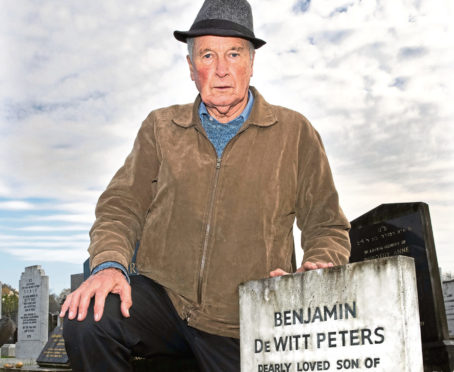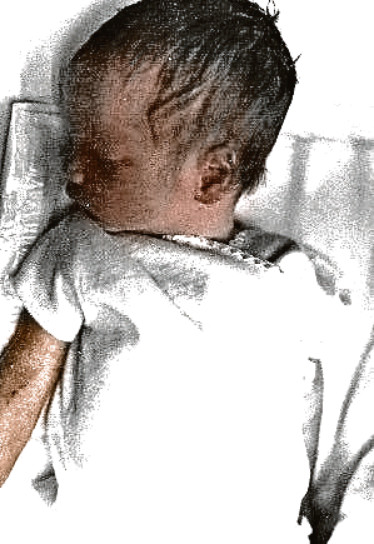
At a little after 10 o’clock on Friday morning, Gordon Peters visited the cemetery where his baby son is buried.
He thought of Benjamin, who died after just one week of life, and wondered about the future he might have had. Sadly, he also wondered, like he has wondered many times before, if, many years ago, police officers stood where he was standing, taking notes while planning to steal his baby’s identity.
Tomorrow, at a public inquiry investigating alarming questions around the morality of undercover policing operations run by the Metropolitan Police in London, he will again seek answers.
Gordon is one of many grieving parents calling on Scotland Yard to confirm the identities of their dead children were used to help build new lives for undercover officers.
The Met has already confirmed two covert squads used the identities of dead children to create personas for officers tasked with infiltrating protest groups.
The inquiry began last week and was told that police had written to families confirming the identities of 19 children had been taken. Benjamin was not among them.
However, an earlier report found more than 42 child identities may have been stolen and Gordon, a former social work director from Bishopton, Renfrewshire, knows the cemetery where his son was buried was scoured by police officers seeking to create false identities.
Benjamin died a week after he was born in 1979 and was laid to rest in Hoop Lane Cemetery in north London. His burial place is marked by a stone charting his short life – and the details needed to source his birth certificate and steal his identity.
Gordon and his ex-wife Judith were devastated and their grief was compounded years later when they discovered that other children buried in the area had their identities stolen.
Gordon, 76, said: “The pain of losing a child is with you forever and you have to learn to live with it. When I asked the Metropolitan Police if Benjamin’s identity had been used for their undercover work they replied that they could neither confirm or deny that it had been.
“We were stunned and hugely dismayed by their response. Frankly, it is not good enough. Most parents would want to know something as important as this when it relates to their child.
“I am not the only parent who wants the truth and we owe it to our deceased children to get it. We already know that many innocent deceased children’s identities were taken and used to create false identities.
“Children whose identities were taken were vulnerable and unable to prevent being used in such a dreadful way. The parents were never informed that this was happening and would never have agreed to it. It is basic human right to know the truth.”
He added: “The police officers who used the identities of dead children infiltrated groups of people the police deemed were subversive or politically active. Some went on to have relationships with women in the groups, while they had families back in their other lives, and then disappear.
“One police officer emigrated to Australia without telling the woman he was in a relationship with that he was going. They were playing with people’s lives.
“To think these things may have been done by officers using my son’s name is hard to accept.”
Gordon’s lawyer will tomorrow launch a legal challenge at the inquiry, to require the Metropolitan Police to say whether Benjamin and other children’s identities were or were not taken.
He said: “I am included tomorrow in the presentation, along with other parents of deceased children who have asked for an assurance that their child’s name was not used by undercover officers to create a false identity. No such assurance has been given.
“Instead, we received a letter from the Metropolitan Police saying they can ‘neither confirm nor deny’ that our children’s identities were stolen for undercover work. That refusal will be challenged by Heather Williams QC on our behalf.”
Gordon is also part of a class action which has been funded by legal aid, he revealed. As a former director of social services in Hackney he was heavily involved with helping families.
“I know a lot about children’s rights and I feel I owe it to my son to get the truth. That is what any parent would ask for – the truth. If Benjamin’s identity was stolen, it was a terrible thing to do.”
His fears are fuelled further by a law currently going through Parliament which will legitimise the use of others for undercover work. He said: “The Human Intelligence and Sources Bill provides for this and the argument will be that it is valid to do this to investigate crimes of terror.”
Today, now retired from his career in social work, Gordon is a voluntary advocate for health, wellbeing and inclusion for the elderly.
His attempts to establish whether police stole his son’s identity means the trauma of his birth and death remains fresh for his parents. He said: “My former wife Judith had a placental abruption. The placenta separates from the womb risking the life of the baby.
“Benjamin was seriously affected by this and survived for only seven days. He was beautiful and weighed a healthy eight pounds. He lived long enough to establish himself as very much part of our family.
“We have four surviving children, one born before Benjamin.
“All we want is the truth. What did they do?”
Inquiry exposes police lies and all the shattered lives left behind
A chance discovery led to the exposure of a secret policing unit and the alarming methods used by officers to win the trust of their targets.
Lisa Jones was enjoying a break with her boyfriend, environmental activist Mark Stone in 2010, when she discovered a passport belonging to him.
It showed his photo but the name beside it was a stranger’s, Mark Kennedy. She then found a mobile phone containing emails from two children, calling her boyfriend “Dad”.
She set about discovering who Kennedy really was – eventually establishing he was an undercover police officer who had been spying on campaigners.
The revelations that followed posed serious questions about the morality of undercover investigations with officers accused of encouraging crimes to be committed and forming long-term deceitful relationships with activists as they infiltrated environmental and anti-apartheid groups.
Bob Lambert, for example, was just one of the officers who posed as a left-wing animal rights activist for five years in the 1980s while serving in the controversial Special Demonstration Squad. He fathered a child with an activist, who was unaware of his identity.
After leaving the force, Lambert became an academic and was, until December 2015, a lecturer in terrorism studies at St Andrews University.
The revelations led to the collapse of a major trial and the quashing of a number of convictions and in 2015 it prompted then-Home Secretary Theresa May to order the setting-up of the Undercover Policing Inquiry – which finally began hearing evidence last week.
Matthew Ryder QC, acting for more than 100 individuals and groups, said undercover officers “encouraged, assisted and acted jointly” in criminal activities, resulting in prison sentences for activists.
The inquiry heard that police used the details of 19 dead babies and one living child to create false identities although the scale of the practice is thought to be much wider.
A 2013 report by former Derbyshire Chief Constable Mick Creedon into the activies of the secretive Special Demonstration Squad (SDS) – created to spy on the protest groups of the late 1960s, but which continued to monitor them for a further four decades – found that at least 42 children’s names were used.
The SDS was disbanded in 2008 but its techniques continued in the unit to which Kennedy belonged – the National Public Order Intelligence Unit.
Over more than four decades, at least 139 police officers were given fake identities to closely monitor the inner workings of more than 1,000 political groups.
Officers lived alongside political campaigners and formed friendships and even romantic liaisons with their targets. At least three fathered children with women they met while undercover.
In Scotland, police deployed 18 undercover officers – said to include Kennedy – to gather information about protesters at the summit of G8 world leaders at Gleneagles in July 2005.
Also among those targeted, it has been claimed, was the Stephen Lawrence family justice campaign – though the Metropolitan Police’s lawyers told the inquiry this had not been deliberate, but was part of other ongoing investigations.
Why was Met asked to review covert cover-up in Scotland?
The police force now accused of sanctioning immoral undercover operations was asked to review the cover-up of a covert policing scandal in Scotland last year.
Police Scotland chief constable Iain Livingstone asked the Metropolitan Police to review his force’s investigation of a cover-up at the now-defunct Scottish Crime and Drugs Enforcement Agency (SCDEA).
The involvement of the Met was questioned by legal experts, politicians and campaigners after The Sunday Post told how the SCDEA had attempted to conceal the scandal.
Livingstone asked the Met to carry out a “peer review” after a whistleblower claimed senior officers had ruined her career and orchestrated a cover-up after she uncovered a financial shambles at the unit running the most important covert police operations. The chaos uncovered could, it was feared, compromise the safety of officers infiltrating some of Scotland’s organised crime groups.
After the shambles was exposed, chiefs ordered officers to burn piles of secret files in a garden incinerator outside the agency’s Paisley HQ.
Last year, the Scottish Police Authority, overseeing the national force, was given only an “executive summary” of the Met review which concluded a cover-up could not be ruled out despite Police Scotland insisting there was no evidence to support the claim.
Dr Nick McKerrell, lecturer in law and civil liberties at Glasgow Caledonian University, said asking the Met to review undercover policing in Scotland was questionable, particularly given the Met’s own issues with undercover policing.
He said: “It was a bizarre decision when there is a full judicial inquiry exploring the Met’s own abuse of the undercover policing function.
“Even under request from the Scottish Parliament this report has not been published. Not even to the body supposedly holding Police Scotland to account, the Scottish Police Authority.
“Abuse of undercover policing does not stop with the issues looked at in the current English inquiry. The lack of transparency surrounding Police Scotland’s involvement in this process is extremely worrying and needs to be ended.”

Enjoy the convenience of having The Sunday Post delivered as a digital ePaper straight to your smartphone, tablet or computer.
Subscribe for only £5.49 a month and enjoy all the benefits of the printed paper as a digital replica.
Subscribe © SYSTEM
© SYSTEM